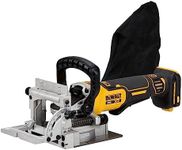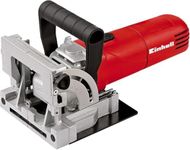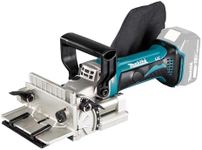Buying Guide for the Best Biscuit Joiners
Choosing the right biscuit joiner can make your woodworking projects easier and more precise. A biscuit joiner, also known as a plate joiner, is a tool used to join two pieces of wood together. It cuts a small slot in the wood where a biscuit (a small, oval-shaped piece of compressed wood) is inserted with glue to create a strong joint. When selecting a biscuit joiner, consider the following key specifications to ensure you pick the best fit for your needs.Motor PowerMotor power, measured in amps, determines how efficiently the biscuit joiner can cut through wood. Higher motor power means the tool can handle denser and thicker materials with ease. For light to medium woodworking tasks, a motor with 5-7 amps is usually sufficient. For more demanding projects or frequent use, consider a motor with 8-10 amps. Assess the types of wood and the frequency of your projects to choose the right motor power.
Blade SizeThe blade size of a biscuit joiner affects the depth and width of the slots it can cut. Common blade sizes are 4 inches, which is suitable for most standard biscuits. Some models offer adjustable blade sizes for versatility. If you plan to work on a variety of projects with different biscuit sizes, an adjustable blade size feature can be beneficial. Consider the typical size of biscuits you will use to determine the appropriate blade size.
Adjustable FenceAn adjustable fence allows you to set the angle and height of the cut, providing greater precision and flexibility. This feature is important for making angled or mitered joints. Look for a biscuit joiner with a sturdy and easy-to-adjust fence. If your projects involve complex joints or require high precision, an adjustable fence is essential. Evaluate the complexity of your woodworking projects to decide if this feature is necessary.
Cutting Depth SettingsCutting depth settings enable you to control how deep the slots are cut into the wood. This is crucial for ensuring the biscuits fit snugly and provide a strong joint. Most biscuit joiners offer multiple depth settings to accommodate different biscuit sizes. If you work with various wood thicknesses and biscuit sizes, a joiner with multiple depth settings will be more versatile. Consider the range of materials you use to determine the importance of this feature.
Dust CollectionDust collection systems help keep your workspace clean by collecting sawdust and debris generated during cutting. This feature is important for maintaining visibility and reducing cleanup time. Some biscuit joiners come with built-in dust bags, while others can be connected to external vacuum systems. If you prioritize a clean workspace and efficient dust management, look for a model with an effective dust collection system. Assess your working environment and cleanliness preferences to choose the right option.
ErgonomicsErgonomics refers to the design and comfort of the tool, including the handle and overall weight. A well-designed, comfortable biscuit joiner reduces fatigue and improves control during use. Look for features like rubberized grips and balanced weight distribution. If you plan to use the tool for extended periods, prioritize ergonomics to ensure comfort and ease of use. Consider how long and how often you will use the joiner to determine the importance of ergonomic features.














